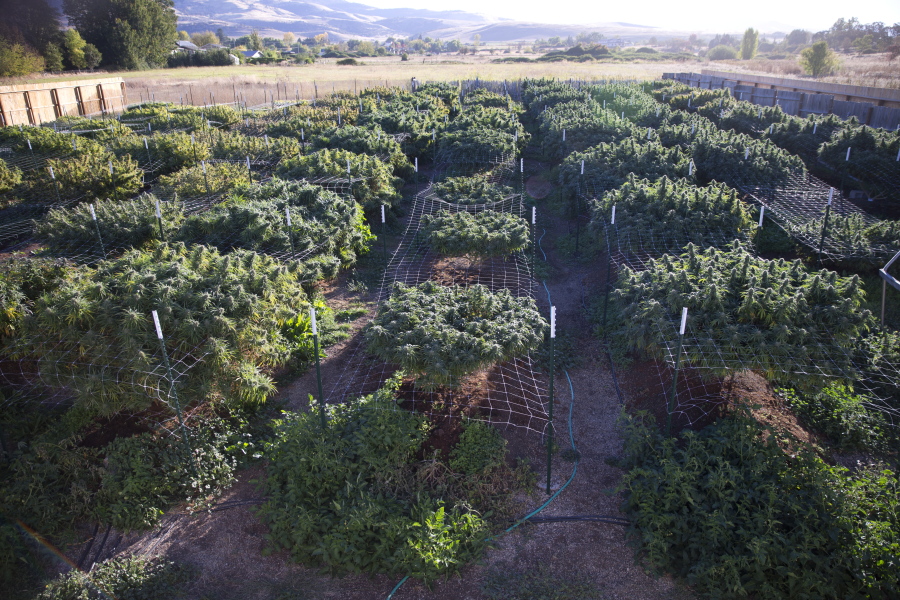SALEM, Ore. — Concerns about pesticide drift are nothing new in agriculture, but the issue has taken on new gravity for Oregon farmers with marijuana-growing neighbors.
Due to Oregon’s pesticide testing regime for marijuana and its high value, growers of more conventional crops worry about getting blamed for contamination that renders the mind-altering flowers unsalable.
“I have neighbors growing marijuana, therefore I’m thinking about it,” said Tim Winn, who farms in Benton County.
The potential problem was recently discussed during the Oregon Farm Bureau’s annual convention, held Dec. 4-6 in Salem, Ore.
County representatives of the organization voted to request that its board of directors consider possible solutions with the Oregon Department of Agriculture, which is one of several state agencies involved in regulating the recreational marijuana since voters legalized it in 2014.
Marijuana remains illegal under federal law, so there are no pesticides specifically registered for use on the psychoactive crop.
Oregon does permit marijuana growers to use certain general biopesticides that aren’t subject to federal residue regulations, but detection of conventional pesticides disqualifies the crop from the commercial market.
“It’s a human consumptive crop so they’re very strict about any impurities,” said Winn.
Neighboring marijuana growers have approached Winn when looking for the source of contamination after their product tested positive for prohibited pesticides, he said.
While Winn replied that he follows all pesticide label regulations, he said it’s still possible that such chemicals can be transferred by dust storms and insects.
Another concern is that marijuana growers can submit claims to a farmer’s liability insurance alleging pesticide drift, which could have serious implications given marijuana’s high value, he said.
While an insurance company may not think much of paying out a claim for a few rows of organic sweet corn that’s been contaminated, an acre of contaminated marijuana would be a much bigger financial hit, Winn said.
As a result, the insurance company may stop insuring similar drift claims in the future or even cancel the farmer’s policy, he said. “You need to be risk averse, so you don’t use that insurance.”
It might make sense for marijuana to only be grown along the edges of “exclusive farm use” zones, as opposed to being surrounded by conventional agriculture on all sides, he said.
However, some growers are concerned about the “right to farm” implications of such proposals.
Tracey Liskey, a Klamath Falls farmer, urged Farm Bureau county delegates to vote against the resolution to discuss the issue with ODA.
“Do we want the state telling us what we can grow and what we can’t?” he said.
Other attempts to resolve coexistence problems through regulation — such as canola restrictions in the Willamette Valley and the prohibition on genetically engineered crops in Jackson County — have turned farmer against farmer, Liskey said.
It’s much better for neighboring growers to work out problems among themselves, such as agreeing to plant buffer crops between their fields, he said.
Exactly how the ODA could help resolve the issue remains to be determined, but the resolution doesn’t change Oregon Farm Bureau’s policy of coexistence among crops, said Mary Anne Cooper, public policy counsel for the organization.
The Farm Bureau’s board of directors will consider the resolution at its meeting in February and then decide whether to take any action, she said.
Under current law, ODA doesn’t have the authority to establish a control district — which would be necessary to regulate where marijuana is grown — unless it’s due to pest and disease risks associated with a crop, said Scott Dahlman, policy director for the Oregonians for Food & Shelter agribusiness group.
Oregonians for Food & Shelter would oppose any legislative action to expand ODA’s control area authority beyond pest and disease risks, he said.
“We’d be disappointed to see a move toward that because we believe in coexistence,” Dahlman said.
Raising the allowable detection level for certain pesticides on marijuana could endanger public safety, as there’s no scientific data about potential safety hazards for the crop, he said.




